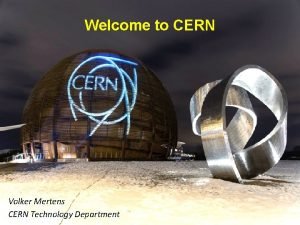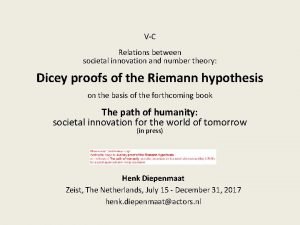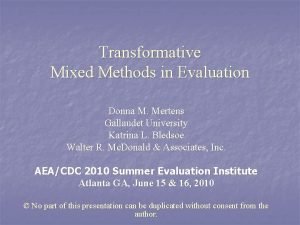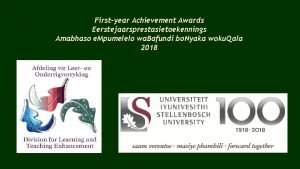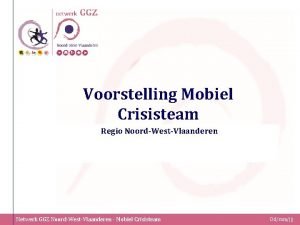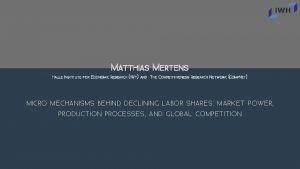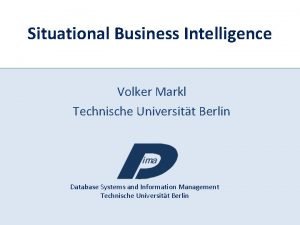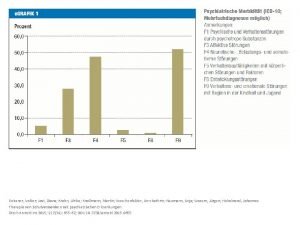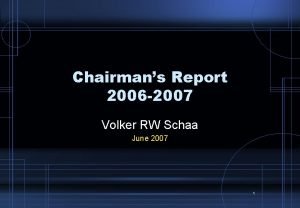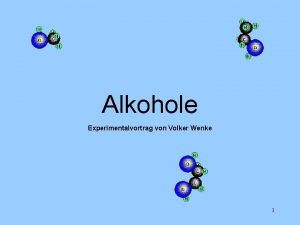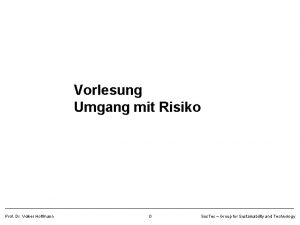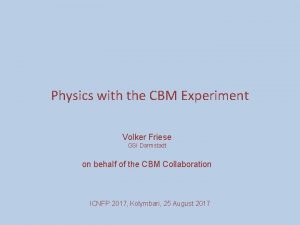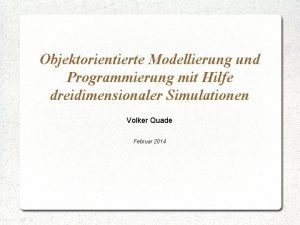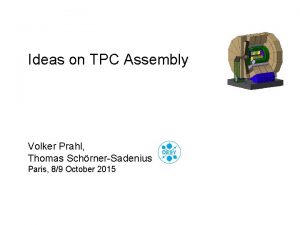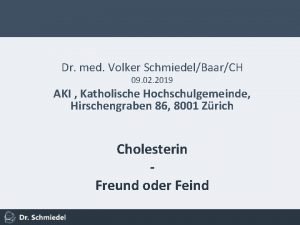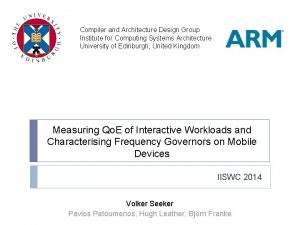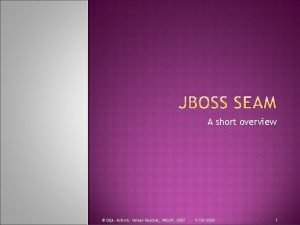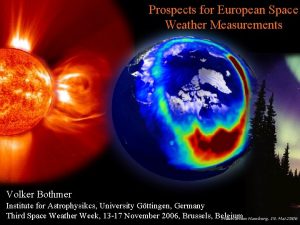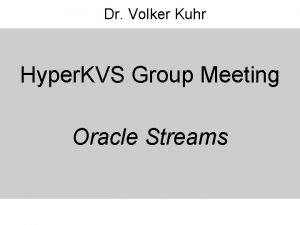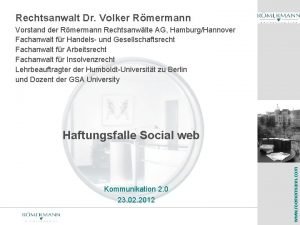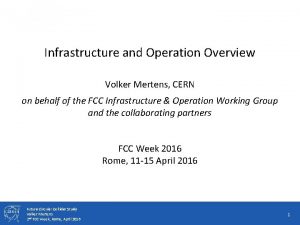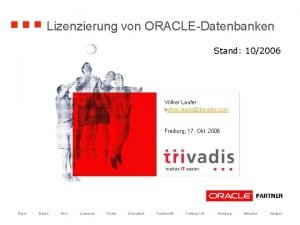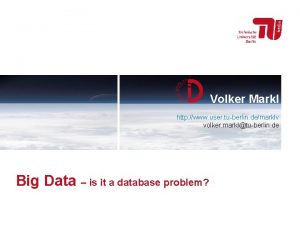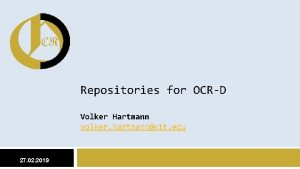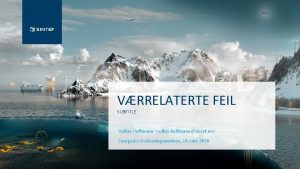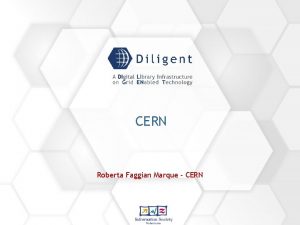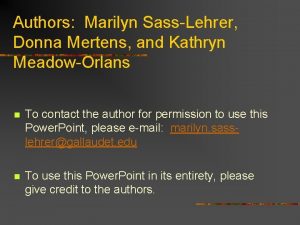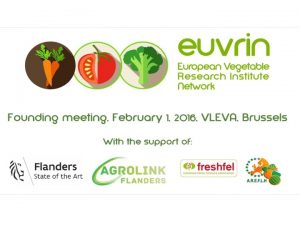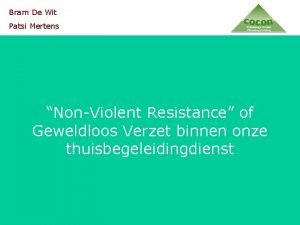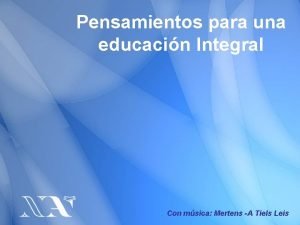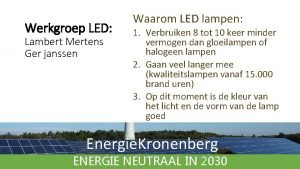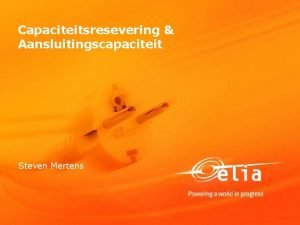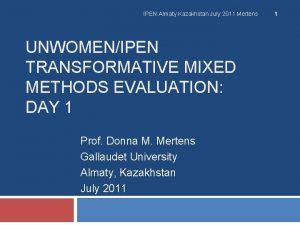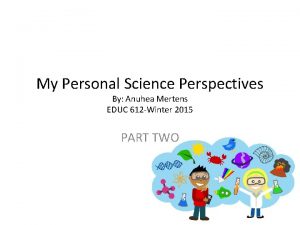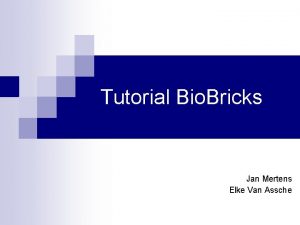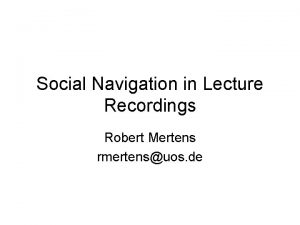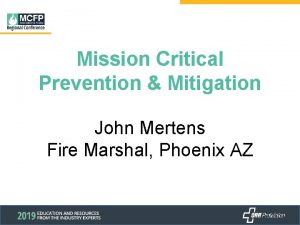Welcome to CERN Volker Mertens Welcome and Introduction
























- Slides: 24

Welcome to CERN Volker Mertens Welcome and Introduction to FCC Study CERNV. Mertens Technology Department 22. 11. 2016 1

Workshop on potential collaboration with FIML in the framework of the FCC study (following up from a visit at FIML, Dortmund, on 23 June 2016) study Programme 22 November 2016 https: //indico. cern. ch/event/576224/ Welcome and Introduction to FCC Study V. Mertens 22. 11. 2016 2

Workshop Programme 23 November 2016 https: //indico. cern. ch/event/576224/ Welcome and Introduction to FCC Study V. Mertens 22. 11. 2016 3

Future Circular Collider Study PS LHC SPS FCC http: //cern. ch/fcc Work Welcome and Introduction to FCC Study V. Mertens supported by the European Commission 22. 11. 2016 under the HORIZON 2020 project Euro. Cir. Col, grant agreement 654305 4

CERN, the European Organization for Nuclear Research, is an intergovernmental organisation which was founded in 1954 (http: //home. cern/about). It has meanwhile 21 Member States. Its seat is in Geneva; its premises are located on both sides of the French-Swiss border. CERN’s mission is to enable international collaboration in the field of high-energy particle physics research. To this end it designs, builds and operates particle accelerators and the associated experimental areas. At present more than 11 000 scientific users from research institutes all over the world are using CERN’s installations for their experiments. The accelerator complex at CERN is a succession of machines with increasingly higher energies. Each machine injects the beam into the next one, which takes over to bring the beam to an even higher energy. The present flagship of this complex is the Large Hadron Collider (LHC; http: //home. cern/topics/large-hadron-collider). Welcome and Introduction to FCC Study V. Mertens 22. 11. 2016 5

Chain of accelerators Welcome and Introduction to FCC Study V. Mertens 22. 11. 2016 6 6

Pre-accelerators LINAC 2 Proton Synchrotron Welcome and Introduction to FCC Study V. Mertens 22. 11. 2016 PS Booster Super Proton Synchrotron 7

LHC Magnet Coil Large Hadron Collider Welcome and Introduction to FCC Study LHC interconnection V. Mertens 22. 11. 2016 8

Detectors ATLAS Welcome and Introduction to FCC Study V. Mertens 22. 11. 2016 9

Data processing Welcome and Introduction to FCC Study V. Mertens 22. 11. 2016 10

High-Energy Physics (HEP) • “Standard model” describes only 5 % of the universe ! Known Matter 4. 9% Dark Matter 26. 8% Dark Energy 68. 3% • • What is dark matter ? What is dark energy ? galaxy rotation curves, 1933 - Zwicky Why is there more matter than antimatter ? Why do the masses differ by more than 13 orders of magnitude ? Do fundamental forces unify in single field theory ? What about gravity ? Is there a “world equation” – a “theory of everything” ? K. Borras Welcome and Introduction to FCC Study V. Mertens 22. 11. 2016 11

Roads to discoveries Smaller Scales Rare Processes Higher Energy Higher Luminosity Welcome and Introduction to FCC Study V. Mertens 22. 11. 2016 12

Strategic motivation for FCC • European Strategy for Particle Physics 2013: “…to propose an ambitious post-LHC accelerator project…. . , CERN should undertake design studies for accelerator projects in a global context, …with emphasis on proton-proton and electron-positron high-energy frontier machines…. coupled to a vigorous accelerator R&D programme, including high-field magnets and high-gradient accelerating structures, …. ” • U. S. strategy and P 5 recommendation 2014: ”…. A very high-energy proton-proton collider is the most powerful tool for direct discovery of new particles and interactions under any scenario of physics results that can be acquired in the P 5 time window…. ” • ICFA statement 2014: ”…. ICFA supports studies of energy frontier circular colliders and encourages global coordination. …. ” Welcome and Introduction to FCC Study V. Mertens 22. 11. 2016 13

Pushing the energy frontier • A very large circular hadron collider seems the only approach to reach 100 Te. V c. m. collision energy in coming decades • Access to new particles (direct production) in the few Te. V to 30 Te. V mass range, far beyond LHC reach. • Much-increased rates for phenomena in the sub-Te. V mass range → increased precision w. r. t. LHC and possibly ILC Hadron collider energy reach compared to LHC factor ~4 in radius, factor ~2 in field O(10) in Ecms Welcome and Introduction to FCC Study V. Mertens 22. 11. 2016 14

Future Circular Collider Study GOAL: CDR and cost review for the next ESU (2018) Geneva PS SPS LHC 27 km, 8. 33 T 14 Te. V (c. o. m. ) 1300 t Nb. Ti Welcome and Introduction to FCC Study V. Mertens 22. 11. 2016 HE-LHC baseline 27 km, 16 T 26 Te. V (c. o. m. ) 2500 t Nb 3 Sn FCC-hh baseline 100 km, 16 T 100 Te. V (c. o. m. ) 10000 t Nb 3 Sn FCC-hh 80 km, 20 T 100 Te. V (c. o. m. ) 2000 t HTS 8000 t LTS 15

Scope: accelerator + infrastructure FCC-hh: 100 Te. V pp collider as long-term goal defines infrastructure needs FCC-ee: e+e- collider, potential intermediate step HE-LHC: based on FCC-hh technology key technologies pushed in dedicated R&D programmes, e. g. 16 Tesla magnets for 100 Te. V pp in 100 km SRF technologies and RF power sources tunnel infrastructure in Geneva area, linked to CERN accelerator complex; site-specific, as requested by European strategy Welcome and Introduction to FCC Study V. Mertens 22. 11. 2016 16

Scope: physics + experiments physics opportunities discovery potentials experiment concepts for hh, ee and he machine Detector Interface studies concepts for worldwide data services overall cost model; cost scenarios for collider options including infrastructure and injectors; implementation and governance models Welcome and Introduction to FCC Study V. Mertens 22. 11. 2016 17

Timescale 1980 1985 1990 Constr. Design 1995 Physics Proto 2000 2005 2010 2015 2020 2025 2030 2035 2040 LEP Construction LHC Physics Design Construction Physics HL-LHC 20 years FCC study Design Proto Construction Physics Now is the right time to plan for the period 2035 – 2040 Goal of phase 1: CDR by end 2018 for next update of European Strategy Welcome and Introduction to FCC Study V. Mertens 22. 11. 2016 18

Study timeline to CDR 2014 Q 1 Q 2 Q 3 2015 Q 4 Q 1 Q 2 Q 3 2016 Q 4 Q 1 Q 2 Q 3 2017 Q 4 Q 1 Q 2 Q 3 2018 Q 4 Q 1 Q 2 Q 3 Q 4 Study plan, scope definition Explore options FCC Week 2015: work towards baseline conceptual study of baseline develop baseline <|> detailed studies FCC Week 2016 Progress review FCC Week 17 & Review Cost model, LHC results study re-scoping? Elaboration, consolidation FCC Week 2018 contents of CDR Report CDR ready Welcome and Introduction to FCC Study V. Mertens 22. 11. 2016 19

International Collaboration • 88 institutes • 28 countries + EC Status: August, 2016 Welcome and Introduction to FCC Study V. Mertens 22. 11. 2016 20

Collaboration Status 87 collaboration members + EC + CERN as host ALBA/CELLS, Spain Ankara U. , Turkey Aydin U, Istanbul, Turkey U Belgrade, Serbia U Bern, Switzerland BINP, Russia CASE (SUNY/BNL), USA CBPF, Brazil CEA Grenoble, France CEA Saclay, France CIEMAT, Spain Cinvestav, Mexico CNRS, France CNR-SPIN, Italy Cockcroft Institute, UK U Colima, Mexico UCPH Copenhagen, Denmark CSIC/IFIC, Spain TU Darmstadt, Germany TU Delft, Netherlands DESY, Germany DOE, Washington, USA TU Dresden, Germany Duke U, USA EPFL, Switzerland UT Enschede, Netherlands ESS, Sweden U Geneva, Switzerland Giresun U. Turkey Welcome and Introduction to FCC Study V. Mertens 22. 11. 2016 Goethe U Frankfurt, Germany GSI, Germany GWNU, Korea U. Guanajuato, Mexico Hellenic Open U, Greece HEPHY, Austria U Houston, USA ISMAB-CSIC, Spain IFAE, Spain IFIC-CSIC, Spain IIT Kanpur, India IFJ PAN Krakow, Poland INFN, Italy INP Minsk, Belarus U Iowa, USA IPM, Iran UC Irvine, USA Isik U. , Turkey Istanbul University, Turkey JAI, UK JINR Dubna, Russia Jefferson LAB, USA FZ Jülich, Germany KAIST, Korea KEK, Japan KIAS, Korea King’s College London, UK KIT Karlsruhe, Germany KU, Seoul, Korea U Sejong, Korea U Liverpool, UK U Lund, Sweden U Malta, Malta MAX IV, Sweden MEPh. I, Russia UNIMI, Milan, Italy MIT, USA Northern Illinois U, USA NC PHEP Minsk, Belarus OIU, Turkey Okan U, Turkey U Oxford, UK PSI, Switzerland U. Rostock, Germany RTU, Riga, Latvia UC Santa Barbara, USA Sapienza/Roma, Italy U Siegen, Germany U Silesia, Poland Stanford U, USA U Stuttgart, Germany TAU, Israel TU Tampere, Finland TOBB, Turkey U Twente, Netherlands TU Vienna, Austria Wigner RCP, Budapest, Hungary Wroclaw UT, Poland 21

First FCC Week Conference http: //cern. ch/fccw 2016 Washington DC 23 -27 March 2015 http: //cern. ch/fccw 2015 468 Participants 168 Institutes 24 Countries Welcome and Introduction to FCC Study V. Mertens 22. 11. 2016 22

Summary status • Consolidated parameter sets for FCC-hh and FCC-ee machines • Complete optics baselines for FCC-hh and FCC-ee, beam dynamics compatible with parameter requirements • Common footprint for both accelerator options • Convergence on main MDI parameters and detector studies • First round of geology and implementation CE and TI studies completed • Full design iteration for next FCC Week conference in May 2017 • Next milestone is a study review at FCC Week 2017 to confirm baseline and define contents of the Conceptual Design Report. Welcome and Introduction to FCC Study V. Mertens 22. 11. 2016 23

Welcome and Introduction to FCC Study V. Mertens 22. 11. 2016 24
 Volker mertens
Volker mertens (770) 905-2309
(770) 905-2309 Mertens transformative paradigm
Mertens transformative paradigm Marko mertens
Marko mertens Marko mertens
Marko mertens Hanne mertens
Hanne mertens Tilia mertens
Tilia mertens Matthias mertens
Matthias mertens Volker pispers zitate
Volker pispers zitate Volker markl
Volker markl Volker jost
Volker jost Leyes de kirchhoff
Leyes de kirchhoff Volker schaa
Volker schaa Volker wenke
Volker wenke Prof. dr. volker hoffmann
Prof. dr. volker hoffmann Volker friese
Volker friese Gloop dokumentation
Gloop dokumentation Unpack armadillo
Unpack armadillo Volker prahl
Volker prahl Dr. med. volker schmiedel
Dr. med. volker schmiedel Volker seeker
Volker seeker Volker reichel
Volker reichel Space weather
Space weather Hyper kvs
Hyper kvs Volker römermann ehefrau
Volker römermann ehefrau
